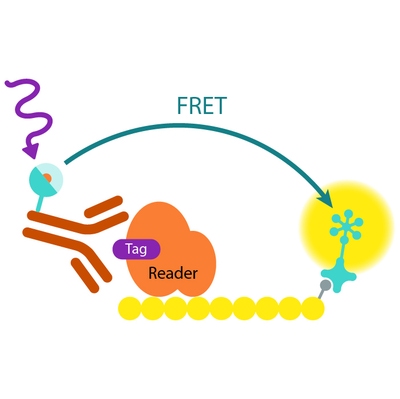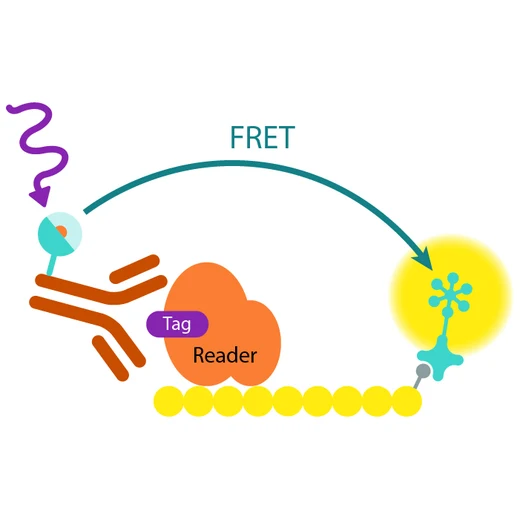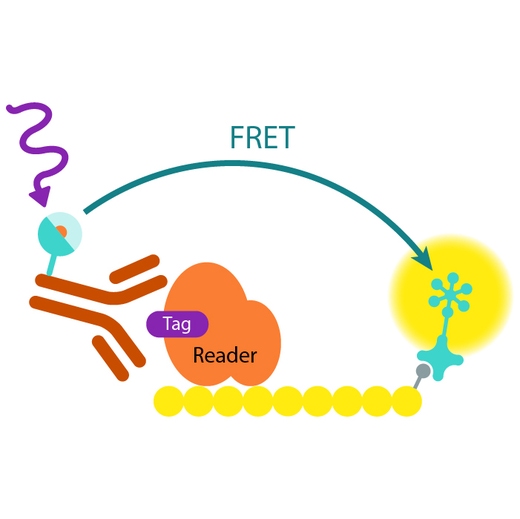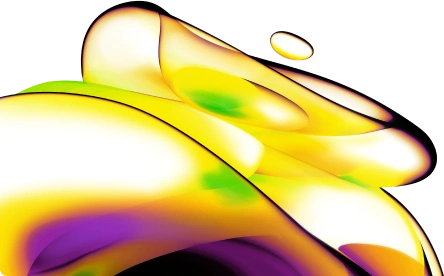

HTRF EPIgeneous Binding Domain C Detection Kit, 500 Assay Points








| Feature | Specification |
|---|---|
| Application | 生化学酵素アッセイ |
| Sample Volume | 120 µL |









Product information
Overview
The EPIgeneous Binding Domain kit series provides a simple biochemical approach to study epigenetic reader domain interactions with modified histones. All kits are based on a GST-tagged binding domain / biotin-coupled Histone peptide format, and can be run using the same add-and-read single plate protocol.
Binding Domain kit C has been successfully validated on 4 different domains, including some important therapeutic targets, in the BRD and ATAD families.
How it works
Assay principle
In EPIgeneous Binding Domain kit B, the GST-tagged reader domain protein binding to the biotinylated peptide substrate is detected by a conjugate mix: anti-GST Tb cryptate-labeled antibody conjugate (donor), and XL665-conjugated streptavidin (acceptor). The interaction of the reader domain with the substrate brings the donor and acceptor dyes into close proximity, and allows FRET to occur upon light excitation. The specific signal at 665 nm is inhibited when a specific compound prevents the reader domain protein from binding to its substrate.
Analytical performance
Peptide-biotin titration - ATAD2 / histone H4 peptide interaction
The validation of the EPIgeneous binding Domain C assay was performed using Bromodomain ATAD2A assay which measures the interaction of ATAD2A with [Lys(5,8,12,16)Ac] H4(1-21) peptide. The GST-ATAD2A concentration was fixed at 5 nM while the peptide-biotin was serially diluted.
The HTRF signal is proportional to the specific interaction between the two partners.
The 400 nM Kd value was determined using a two-site specific binding regression. A slight shift of apparent Kd is observed while DMSO% increases, likely due to the competitive inhibitor nature of DMSO on this interaction.

DMSO tolerance - peptide-biotin concentration optimization
Due to the competitive nature of DMSO, the assay window decreased as the DMSO % increased. The assay window can then be recovered by increasing the biotinylated peptide concentration. The best compromise was found between the real Kd and EC100 obtained in DMSO free conditions.
Note that the the higher the biotin-peptide concentration, the higher the inhibitor IC50. 1% DMSO and 300 nM were considered for further experiments.

Inhibitor titration - ATAD2A by reference compound
The HTRF assay was performed using 100 nM peptide-biotin, 5 nM GST-ATAD2A and 1% DMSO set constant throughout the inhibitor titration. As expected, the [Lys(5,8,12,16)Ac] H4(1-25) peptide displayed low affinity for ATAD2A.

Assay validation
Validated binding domains
Three kits (A, B and C) have already been validated and fully optimized on a selection of 28 key binding domains. For non-validated reader domains, a fourth one, the Discovery Kit, enables researchers to profile which of the A, B or C kits is the best assay solution.
| BINDING DOMAIN KIT A | BINDING DOMAIN KIT B | BINDING DOMAIN KIT C |
|---|---|---|
| BRD2(1) | CECR2 | BRD4(1/2) |
| BRD3(1) | FALZ (BPTF) | ATAD2A |
| BRD4(1) | BRD2(2) | ATAD2B |
| CBX 1 | BRD2(1/2) | BRD9 |
| BRD3(2) | SMARCA4 (BRG1) | |
| BRD3(1/2) | BAZ2B | |
| BRD4(2) | ||
| BRDT(1) | ||
| BRDT(1/2) | ||
| CREBBP | ||
| BRD1 | ||
| BRPF3 | ||
| TAF1L(2) | ||
| TAF1L(1/2) | ||
| TAF1(2) | ||
| TAF1(1/2) | ||
| L3MBTL1 | ||
| UHRF1 |
Specifications
| Application |
Biochemical Enzymatic Assay
|
|---|---|
| Brand |
EPIgeneous
|
| Detection Modality |
HTRF
|
| Product Group |
Kit
|
| Sample Volume |
120 µL
|
| Shipping Conditions |
Shipped in Dry Ice
|
| Target Class |
Epigenetics
|
| Technology |
TR-FRET
|
| Therapeutic Area |
Metabolism/Diabetes
Neuroscience
Oncology & Inflammation
|
| Unit Size |
500 assay points
|
Video gallery
Resources
Are you looking for resources, click on the resource type to explore further.
Discover the versatility and precision of Homogeneous Time-Resolved Fluorescence (HTRF) technology. Our HTRF portfolio offers a...
This guide provides you an overview of HTRF applications in several therapeutic areas.


How can we help you?
We are here to answer your questions.






























